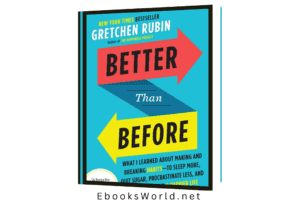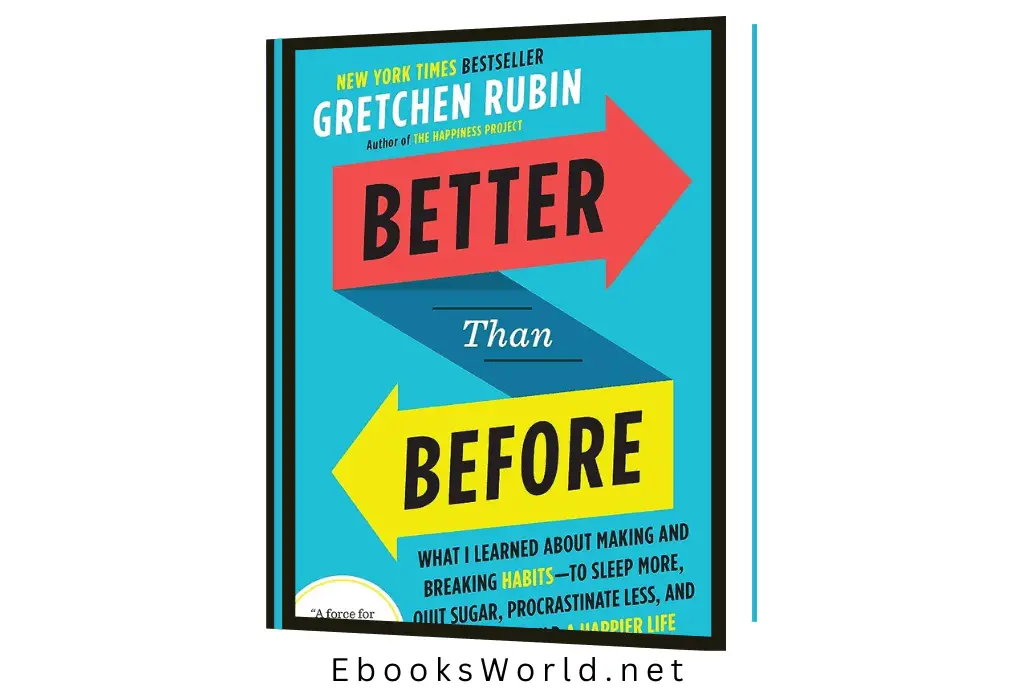Better Than Before

“Better Than Before: What I Learned About Making and Breaking Habits—to Sleep More, Quit Sugar, Procrastinate Less, and Generally Build a Happier Life” is a book by Gretchen Rubin that explores the science and psychology behind habit formation. Published in 2015, the book provides valuable insights into understanding and changing habits to improve one’s overall well-being and happiness. Here is a comprehensive summary of the key concepts in “Better Than Before” in approximately 1000 words:
Understanding Habits:
1. The Four Tendencies: Rubin introduces the concept of the Four Tendencies, a framework that categorizes people based on how they respond to inner and outer expectations. The four tendencies are Upholders, Questioners, Obligers, and Rebels. Understanding one’s tendency is crucial for effective habit formation.
2. Habit Loops: The author explains the habit loop, consisting of cue, routine, and reward. Identifying and understanding these components is essential for both forming new habits and breaking old ones.
Strategies for Habit Formation:
3. Foundational Habits: Rubin emphasizes the importance of foundational habits, such as getting enough sleep, exercising regularly, and controlling stress. These habits provide a solid base for building other positive habits.
4. Monitoring and Accountability: Regular monitoring of habits and being accountable to oneself or others are powerful tools for habit formation. Rubin discusses the use of accountability partners and tracking tools to reinforce positive behavior.
5. Scheduling and Routine: Creating a specific schedule and routine helps in making habits automatic. Rubin suggests identifying the most suitable time for different activities and sticking to a consistent schedule.
6. Strategy of Pairing: The book introduces the concept of pairing, where a new habit is linked to an existing habit. This helps in integrating the new behavior seamlessly into daily life.
7. Clarity and Specificity: Clear, specific goals are more likely to be achieved. Rubin advocates for defining habits in precise terms to enhance clarity and increase the chances of success.
Habit Types:
8. Abstainers vs. Moderators: Rubin discusses two personality types when it comes to habits: abstainers, who find it easier to give up a habit entirely, and moderators, who do better when they can indulge in moderation. Understanding one’s type can inform the approach to habit change.
9. Small Steps and Gradual Change: The concept of “The Strategy of the Clean Slate” is introduced, encouraging individuals to make changes at key moments (like the start of a new week or month) for a fresh start. Small, gradual steps are often more sustainable than drastic changes.
10. The Lightning Bolt Moment: Some people experience a sudden, transformative moment that sparks a change in their habits. Rubin explores the role of such lightning bolt moments in habit formation and personal transformation.
Challenges in Habit Formation:
11. Obstacles and Stumbling Blocks: Rubin acknowledges common obstacles to habit formation, such as lack of time, boredom, and the difficulty of making decisions. Understanding and addressing these challenges is crucial for overcoming them.
12. Convenience and Inconvenience: The book discusses the impact of convenience and inconvenience on habit formation. Making desired behaviors more convenient and undesirable behaviors less convenient increases the likelihood of success.
Habit Breaking:
13. Identifying and Breaking Bad Habits: Rubin provides strategies for breaking bad habits, emphasizing the importance of self-awareness and understanding the underlying motivations for these habits.
14. The Strategy of Distraction: Introducing the Strategy of Distraction, Rubin suggests redirecting attention away from negative habits by engaging in positive activities or focusing on a different aspect of the situation.
Maintaining Momentum:
15. Celebrating Success: Celebrating small victories and acknowledging progress is essential for maintaining motivation. Rubin encourages readers to recognize and reward their efforts.
16. Avoiding the Finish Line Fallacy: The Finish Line Fallacy refers to the misconception that reaching a goal or milestone will bring eternal happiness. Rubin advises against this mindset and encourages continuous growth and improvement.
Personalization and Individual Differences:
17. The One-Size-Fits-All Myth: Rubin dispels the myth of a universal approach to habit formation, emphasizing the importance of tailoring strategies to individual preferences, tendencies, and circumstances.
18. Self-Knowledge and Experimentation: The book encourages self-reflection and experimentation to discover what strategies work best for each individual. It acknowledges that there is no one-size-fits-all solution to habit change.
Conclusion:
“Better Than Before” provides a comprehensive guide to understanding, forming, and breaking habits. By exploring the Four Tendencies, habit loops, and various strategies for habit change, Gretchen Rubin offers a roadmap for individuals seeking to create positive transformations in their lives. The book emphasizes the importance of self-awareness, personalization, and continuous effort in building a happier and more fulfilling life through intentional habit formation.







